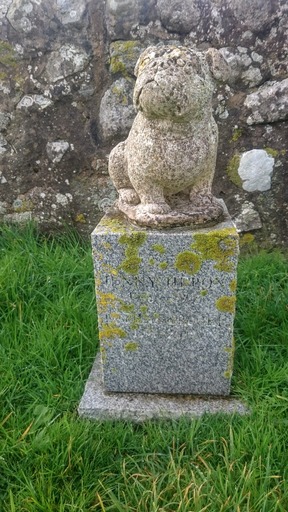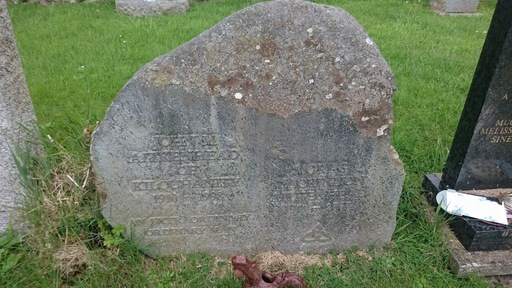By: Simon Brooke :: 5 May 2021
This is a wee graveyard, as you can see; but it's my graveyard, the graveyard local to me. And I've come here to talk about truth, and belief, and honesty, and death, and Scotland's place as a nation, and contested versions, because it's a good place to do that.
This is my mother's grave, and my wee sister's. My mother was a historian, and a quaker, as I was much of my life; she wanted a plain gravestone, with just her name and dates, in the quaker tradition. My wee sister Jenny was not a quaker, as I'm not now; and she was mischievous and iconoclastic and kept hideous pug dogs; and she wanted her dug on her stane; and her death was so unexpected and so tragic that we'd none of us the heart to deny her.
So we have this bizarre and ugly compromise, of the plain granite stone with names and dates, and a tacky cast statue of a pug on top of it.
And I want to add Jenny's daughter's — my niece Zoe's — name and dates, too, because she too is dead, and she too was a person of this place; but she's not in truth buried here; and I don't know, with one quaker standard of truth, how to memorialise someone who isn't actually here.
Soon I shall be dead, too. My body won't be buried here either; it will be in the medical school at Edinburgh university, being cut up by students, because that's my choice. Should my name and dates, too, go on the stone? The name and dates are facts, but the place is not a fact.
You've never heard of Edward, King of Scots, have you? He inherited the throne from his father, John, King of Scots, in 1314 — the year of Bannockburn. See that wee island down there in the bay? I'm not sure you will, it's an awfy small island, you could walk all round it in half an hour. And if you walk up the ridge of the island from the landing beach towards the summit on a dry day in summer, you'll find the outlines in the grass of quite a large, rectangular building. There's not a single stone standing on another now; and there's no piles of masoned stone. It cannot have been a stone building.
In the distance, across the firth, beyond the island, you'll see the hills of England. And it's history — documented, attested history — that Edward, King of Scots, lived for some considerable time on that island, down there in the bay, getting his supplies by ship from England.
So: was he King of Scots?
As Zaphod Beeblebrox would say, hey, what is truth, man?
John Balliol was King of Scots. He was King of Scots because he was chosen, by a conference of the Auditors of Scotland, in 1291, as the best qualified candidate after the death of Alexander the Second, King of Scots without issue. The conference was chaired by Edward the First, King of England, because he was chosen by the Scots as a neutral chair.
The Bruce faction will claim that John was chosen because he'd promised to swear fealty to King Edward the First of England; but so had Robert Bruce, and the conference appears from the record to have made its choice on consanguinity.
The Bruce faction will say, also, that John was an English puppet. On the contrary, he was nothing of the sort: it is recorded and attested history that he fought wars to defend Scotland against the English throughout the whole of his reign. Until he was utterly defeated by them.
So why do you know of Robert Bruce, King of Scots, and not of Edward, King of Scots?
Because Robert won. Because all those years Edward was sitting out there on that little Island in the bay, in his wooden house, being supplied by English ships from across the water, Robert was actually governing from Edinburgh and Stirling and Dunfermline and whereever else in all braid Scotland he chose to hold his court — except that wee island.
Do I know Edward Balliol lived on that island? Yes, I do; it's history, there are contemporary records. Do I know he lived in a wooden house? No, I don't. I believe it, and I've good reason to believe it. There are no ruins of a substantial stone building anywhere on the island. There are, as I say, marks in the grass in dry weather of a large rectangular building, such as would be left by a wooden house. It cannae have been a castle; it cannae have been a palace. It cannae have been bigger than a decent modern farmhouse. And I don't know, as a matter of fact, what the dates of those marks in the grass are. But there's no other evidence anywhere else on the island of any substantial structure.
But belief is not fact.
In today's Scotland, too, the leadership of the nation is contested. The Salmond faction — or the Alba party, if you prefer — claim a lot of things. Some of those things are facts, and some of them are beliefs. They have reasons for their beliefs, and some of their reasons, to them, anyway, seem good.
One of the things they believe is that Sturgeon — the leader who is, at the moment, winning, who is actually governing from Edinburgh or wherever else in all braid Scotland she chooses to hold her cabinet — actually isn't serious about independence. That, as Bruce claimed of Balliol, she's happy to keep Scotland in a subordinate relationship with England. And the problem with that belief is that I, too, partly believe it.
There are reasons for that belief that are rational. I could talk to you about the number of times that Sturgeon has claimed that she was about to call another independence referendum — that it would happen "this year", whether that year was 2016, or 2017, or 2019, or 2020, or "as soon as we've recovered from Covid" — and about the fact she's (so far) never delivered. And all that is facts, and true. She has made those promises. She hasn't delivered.
But Scotland is an emotional idea, and our reasons for cleaving to it are emotional reasons. So I'll walk you round this graveyard and explain to you why I — emotionally — believe that Sturgeon is not serious about independence, or, at least, not very — not sufficiently — serious.
Here, just in front of my family grave, is John and Morag Aitkenhead's equally plain and simple stone. People who have been in the independence movement for a long time will remember John Aitkenhead. He was a passionate supporter of independence throughout his life. He was a conscientious objector in the second world war, and then founded and ran for the rest of his life Scotland's first free school, at Kilquhanity. He died without ever seeing Scotland free.
Across from John Aitkenhead's grave is Hughie Paton's, and that's appropriate, because they were close friends. Hugh was a farmer, of the good land at the head of the bay; but in the second world war he was a squadron leader in bombers. He too was a lifelong supporter of independence, and a lifelong communist. Shortly after the war, he drove with another good friend, Christopher Murray Grieve (better known as Hugh MacDiarmid), from Auchencairn in Scotland to Moscow in Russia, in an old Jaguar of Hugh Paton's. Hugh, too, died without ever seeing an independent socialist republic of Scotland.
I knew both John and Hugh, but they were not friends of mine; they were my parent's generation, their children are my friends. Just along from Hughie's grave is that of someone closer to me in age, someone who was a good friend and neighbour of mine: Davie Gordon's. He was a joiner to trade, although he apprenticed as a wheelwright — yes, for wooden carts. He played the bass drum in the Kirkcudbright pipe band for many decades, although it deafened him and gave him tinnitus. He, too, campaigned for Scotland's independence all his long life. Davie died in a Scotland still ruled from Westminster.
You will have heard of Mary, Queen of Scots. Her life, her reign, are written, attested history. But her rule of Scotland, her place in Scotland's history, too, was contested. Indeed, curiously, as Salmond's has been, largely contested on the grounds of alleged sexual misconduct. But in the end, like Edward, King of Scots, she lost, and fled. That is fact.
I believe that she fled from here, from this parish; that she spent her last night in Scotland at Hazelfield House, high on the hill, just below my own croft. I have good reasons for that belief. It's a strong oral tradition here, and Hazelfield was at the time the residence of the (lay) estate factor for Dundrennan Abbey, and thus quite likely where a high status female guest of the abbey would be put up. A bay on the coast below Hazelfield is called Port Mary, and just across the water from it is Maryport, in England, where she landed.
But that isn't documented. There is no contemporary written record of where Mary Stuart got into the boat to leave Scotland for the last time. And it's contested; there is at least one other place, further east than here, which makes a similar claim.






